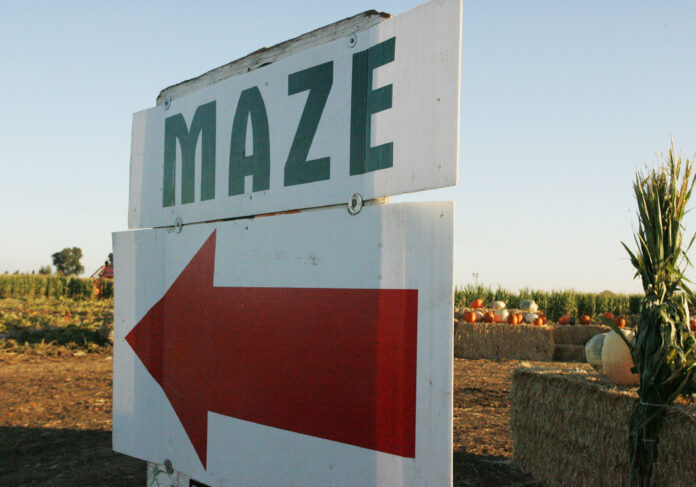Every fall, the Cool Patch Pumpkins farm draws world record aficionados, families, students and corn maze lovers to its fields.
Now listed in the Guinness Book of World Records as the world’s largest temporary corn maze, it’s hard to believe that a few short years ago, the farm was nothing more than a roadside pumpkin patch.
“We started planting a small batch of pumpkins about 12 years ago for [the Halloween season]. At that time, we pretty much had to beg people to stop off the road so we could give away the pumpkins,” said Seth Cooley, a 2012 UC Davis mechanical engineering graduate whose family founded the maze.
The idea for including a maze came about as a way to supplement their pumpkin sales, but it soon turned into a challenge to create something extraordinary.
“The interest in our farm was pretty low. We needed something to attract more people, so we decided to make a small-scale corn maze,” Cooley said. “We became curious as to what the biggest corn maze was in the world, and it was only 18 acres, which is really small by farming standards. We knew we could blow that out of the water.”
From there, Seth’s father Matt and his uncle Mark Cooley set about designing their record-breaking maze. They used an Excel file to visualize the corn field as a grid with coordinates, and from there, they mapped out the entire maze.
The design was then transferred to the field with flags and tape measures to match the computer file. A small fleet of weed eaters then cut down around one-tenth of the total corn to make the path, and after a few long, hot summer days, the 40 acre maze was completed.
From there came the arduous process of getting the Guinness Book of World Records to survey the maze. The official record states that the maze measured 163,853.83 m² (40.489 acres) when opened to the public in September 2007. Since that time, the maze has been expanded to 53 acres.
“One of the reasons that we expanded was that toward the end of year, there are droves and droves of people coming through the maze. The corn can get a bit bulldozed. We make it larger with the hope that near the end of the season, there are larger areas that people haven’t trampled,” Cooley said.
As the years have gone on, techniques for growing the corn have been perfected. Seth explained that vandalization of the paths is to be expected, but that it is important to plant the corn stalks close enough together to discourage people from cutting through while also far apart enough that the stalks will have enough room to grow thick and resilient.
Each year, the maze is completely redesigned, with only one aspect maintained: there is only one true path out. As a result, every guest is given a map, even if they do not think they need one.
“There is no way that it could have been done without a map,” said second-year food science major Melanie Barnes, who visited the maze earlier this year. “It feels massive. To get into the actual maze, you have to walk up this bridge, and when you get to the top, you just see this expanse. The corn goes all the way to the horizon. It’s amazing.”
Fifth-year environmental science and management major Mario Evangelista agreed.
“We needed the map, for sure. There were stakes in the ground that marked where you were, and without the map we would have been so lost,” Evangelista said.
Each year, the Cooleys experiment with designs to fool their guests.
“One thing that we have this year is a whole corner of the maze which is nothing but intersecting circles,” Cooley said. “Even for me, who helped cut it — I get lost really easily. When there is nothing but lefts and rights, it’s easy to read the map. With the circles, it’s harder because you’re never really sure which one you are inside of.”
When a design aspect causes one of Cool Patch Pumpkin’s own to get turned around, it is likely even worse for a guest.
“With no straight lines, the circles were really hard. We got lost a few times,” Evangelista said. “It took us two hours to get through the maze, mostly because we got lost in the circles.”
Cooley estimates that the average time through the maze this year is around an hour and forty minutes. However, some maze-goers try to run through it faster for personal achievement.
“We timed it for fun — it took us an hour and 2 minutes,” Barnes said. “We had a really good leader who likes mazes. We couldn’t have gone nearly that fast without him.”
As the season closes, the field will be leveled to mitigate fire hazards and make way for the next year’s new design ideas. Afterward, however, the corn does not go to waste.
“We plant the corn very late by the standards of a corn field, so it’s green when people are in it, and we want it all gone by winter. What happens is when we close the maze, we chop it all down for silage, level it and feed all that green compost to cows,” Cooley said.
As the years go on, the Cooleys plan on continuing to expand the size of their corn maze to maintain their world record. The maze is open this year until Nov. 3.




